TCP/IP Internetworking: OSI vs TCP/IP, Hands-On Project, ARP, Case Study Task
VerifiedAdded on 2023/06/13
|14
|2273
|183
AI Summary
This article discusses the difference between OSI and TCP/IP model, Hands-On Project, Address Resolution Protocol (ARP), and Case Study Task in TCP/IP Internetworking. It provides a detailed simple addressing solution and justification for network design. The article also explains the purpose of ARP Cache and what happens if the number of hosts increases.
Contribute Materials
Your contribution can guide someone’s learning journey. Share your
documents today.
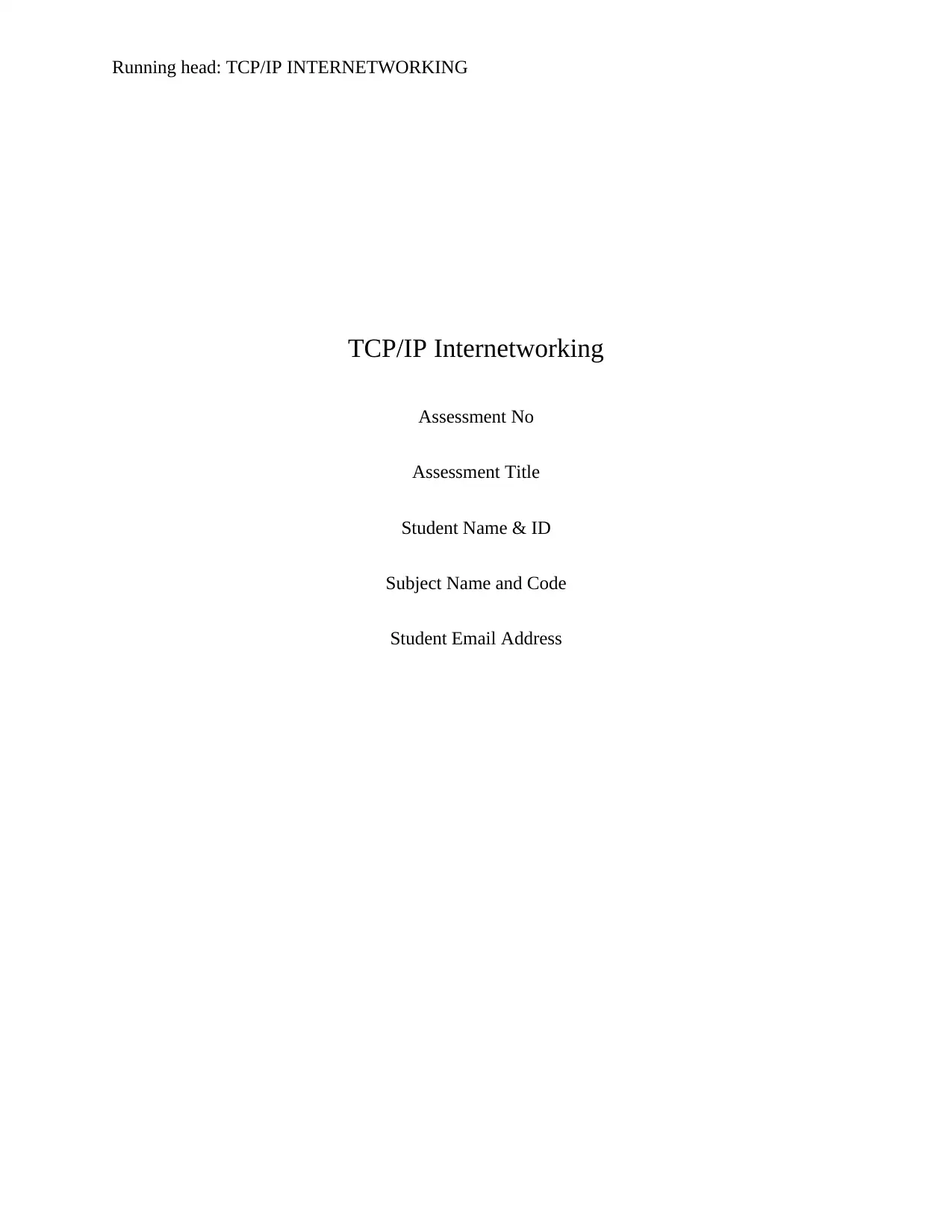
Running head: TCP/IP INTERNETWORKING
TCP/IP Internetworking
Assessment No
Assessment Title
Student Name & ID
Subject Name and Code
Student Email Address
TCP/IP Internetworking
Assessment No
Assessment Title
Student Name & ID
Subject Name and Code
Student Email Address
Secure Best Marks with AI Grader
Need help grading? Try our AI Grader for instant feedback on your assignments.
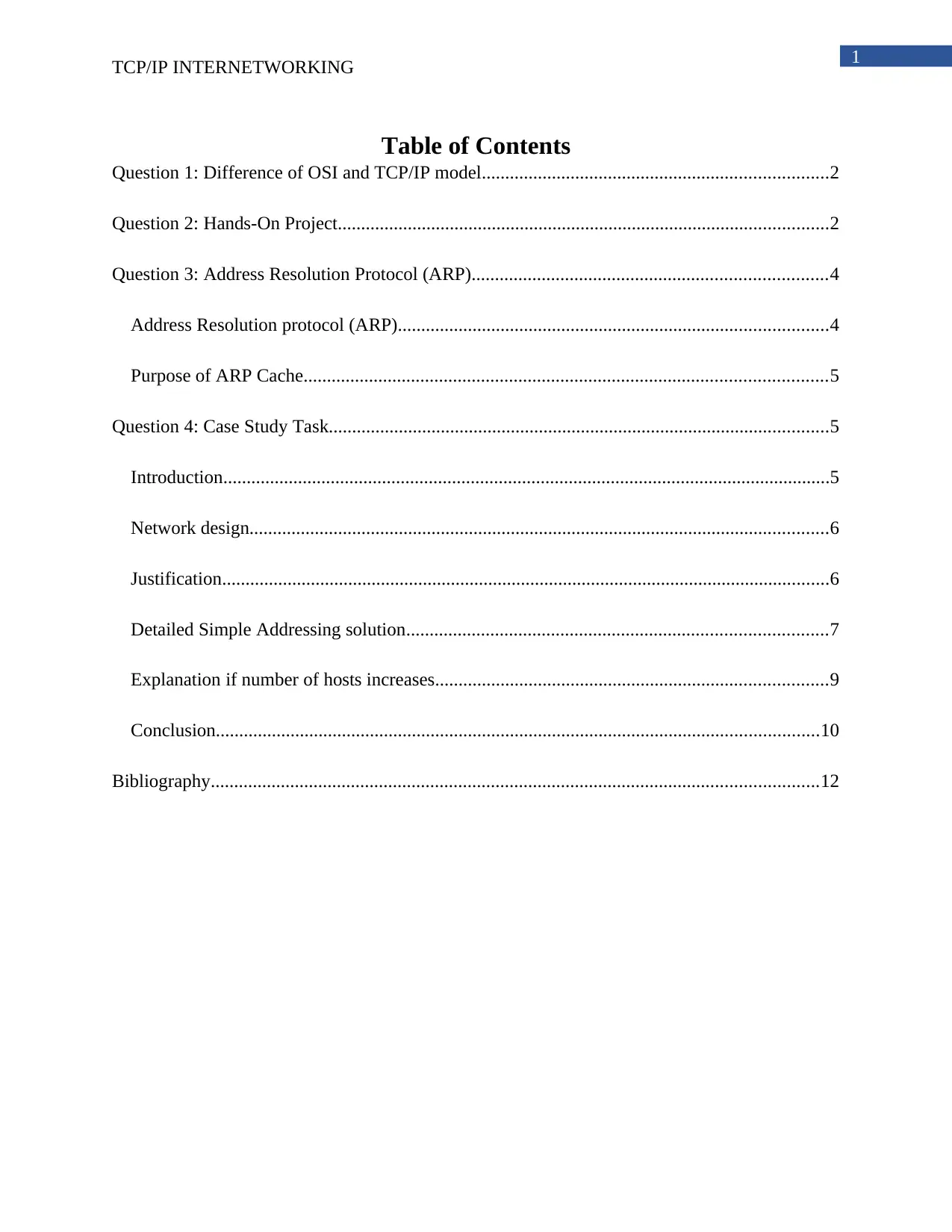
1
TCP/IP INTERNETWORKING
Table of Contents
Question 1: Difference of OSI and TCP/IP model..........................................................................2
Question 2: Hands-On Project.........................................................................................................2
Question 3: Address Resolution Protocol (ARP)............................................................................4
Address Resolution protocol (ARP)............................................................................................4
Purpose of ARP Cache................................................................................................................5
Question 4: Case Study Task...........................................................................................................5
Introduction..................................................................................................................................5
Network design............................................................................................................................6
Justification..................................................................................................................................6
Detailed Simple Addressing solution..........................................................................................7
Explanation if number of hosts increases....................................................................................9
Conclusion.................................................................................................................................10
Bibliography..................................................................................................................................12
TCP/IP INTERNETWORKING
Table of Contents
Question 1: Difference of OSI and TCP/IP model..........................................................................2
Question 2: Hands-On Project.........................................................................................................2
Question 3: Address Resolution Protocol (ARP)............................................................................4
Address Resolution protocol (ARP)............................................................................................4
Purpose of ARP Cache................................................................................................................5
Question 4: Case Study Task...........................................................................................................5
Introduction..................................................................................................................................5
Network design............................................................................................................................6
Justification..................................................................................................................................6
Detailed Simple Addressing solution..........................................................................................7
Explanation if number of hosts increases....................................................................................9
Conclusion.................................................................................................................................10
Bibliography..................................................................................................................................12

2
TCP/IP INTERNETWORKING
Question 1: Difference of OSI and TCP/IP model
There are different communication protocols used for connecting the host in the internet
and it acts as a gateway for sending and receiving the data packets to the sender and the receiver
connected in the network. The OSI model is developed to act as a reference model but the
TCP/IP model is developed from the OSI model. There are four layers in the TCP/IP model
whereas the OSI reference model uses seven layers for its operation. The OSI model is based on
networking theory and thus it is considered as a theoretical model and it does not find its
application in the internet. The TCP/IP model is a practical model and it is more reliable than the
OSI model. The OSI model has strict boundaries and protocols but the TCP/IP adds flexibility to
the network and only follows the general guidelines that should be met for the development of
the network. The connectionless protocols are supported by the TCP/IP model but both the
connectionless and the connection oriented protocols are supported by the OSI reference model.
The TCP/IP model have distinct presentation and session layers whereas the OSI layer
only has a single layer known as the application layer. The TCP/IP model is a primitive one and
the protocol were developed after the development of the model was completed and hence the
model follows a protocol independent standard. On the other hand the OSI model development
was done after the development of the protocols and the model follows the protocol dependent
standards.
Question 2: Hands-On Project
Hands on Project 2.3:
The table provided below provides the subnet mask calculation for the IP4 addressing
mode with the IP as 192.168.0.0 and the number of addresses to be 24.
TCP/IP INTERNETWORKING
Question 1: Difference of OSI and TCP/IP model
There are different communication protocols used for connecting the host in the internet
and it acts as a gateway for sending and receiving the data packets to the sender and the receiver
connected in the network. The OSI model is developed to act as a reference model but the
TCP/IP model is developed from the OSI model. There are four layers in the TCP/IP model
whereas the OSI reference model uses seven layers for its operation. The OSI model is based on
networking theory and thus it is considered as a theoretical model and it does not find its
application in the internet. The TCP/IP model is a practical model and it is more reliable than the
OSI model. The OSI model has strict boundaries and protocols but the TCP/IP adds flexibility to
the network and only follows the general guidelines that should be met for the development of
the network. The connectionless protocols are supported by the TCP/IP model but both the
connectionless and the connection oriented protocols are supported by the OSI reference model.
The TCP/IP model have distinct presentation and session layers whereas the OSI layer
only has a single layer known as the application layer. The TCP/IP model is a primitive one and
the protocol were developed after the development of the model was completed and hence the
model follows a protocol independent standard. On the other hand the OSI model development
was done after the development of the protocols and the model follows the protocol dependent
standards.
Question 2: Hands-On Project
Hands on Project 2.3:
The table provided below provides the subnet mask calculation for the IP4 addressing
mode with the IP as 192.168.0.0 and the number of addresses to be 24.
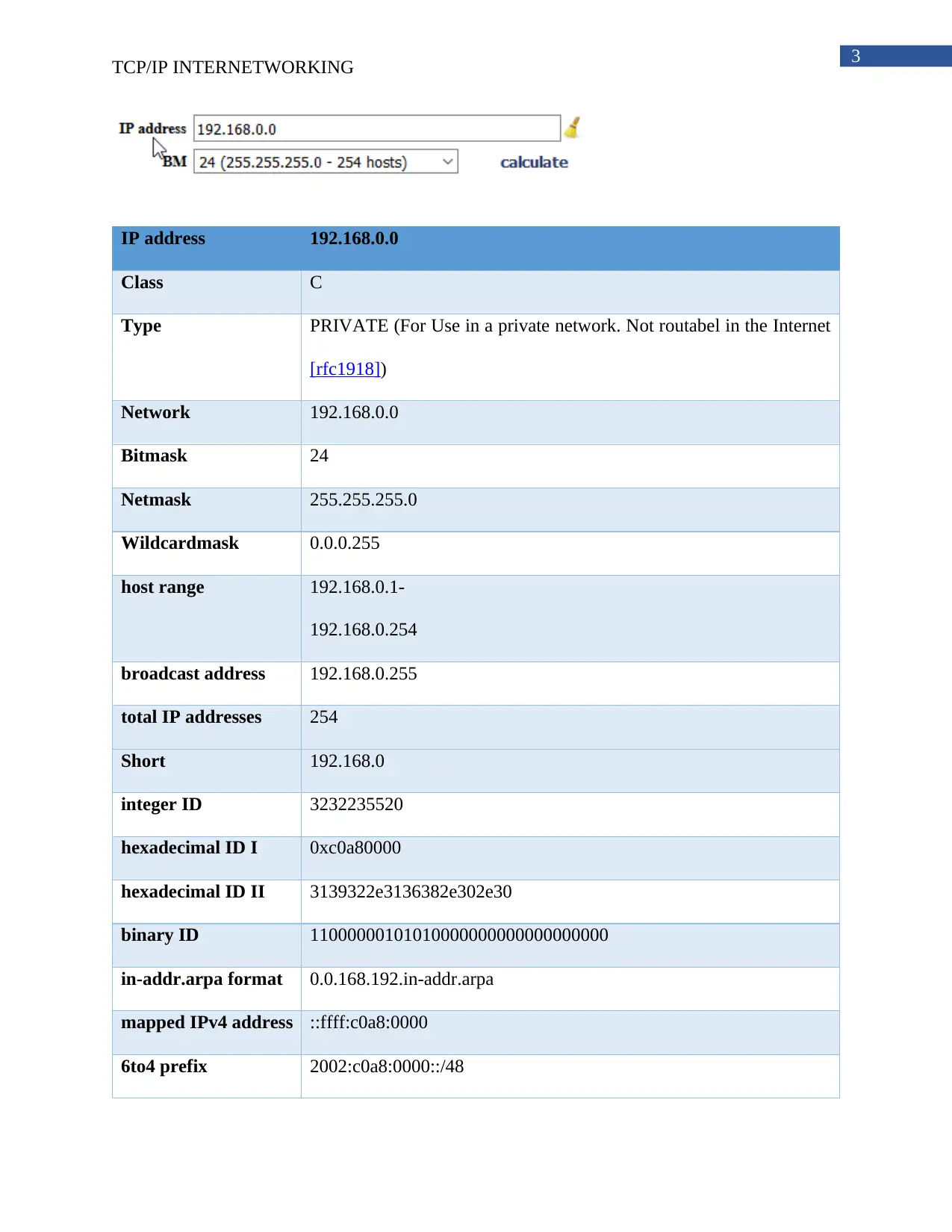
3
TCP/IP INTERNETWORKING
IP address 192.168.0.0
Class C
Type PRIVATE (For Use in a private network. Not routabel in the Internet
[rfc1918])
Network 192.168.0.0
Bitmask 24
Netmask 255.255.255.0
Wildcardmask 0.0.0.255
host range 192.168.0.1-
192.168.0.254
broadcast address 192.168.0.255
total IP addresses 254
Short 192.168.0
integer ID 3232235520
hexadecimal ID I 0xc0a80000
hexadecimal ID II 3139322e3136382e302e30
binary ID 11000000101010000000000000000000
in-addr.arpa format 0.0.168.192.in-addr.arpa
mapped IPv4 address ::ffff:c0a8:0000
6to4 prefix 2002:c0a8:0000::/48
TCP/IP INTERNETWORKING
IP address 192.168.0.0
Class C
Type PRIVATE (For Use in a private network. Not routabel in the Internet
[rfc1918])
Network 192.168.0.0
Bitmask 24
Netmask 255.255.255.0
Wildcardmask 0.0.0.255
host range 192.168.0.1-
192.168.0.254
broadcast address 192.168.0.255
total IP addresses 254
Short 192.168.0
integer ID 3232235520
hexadecimal ID I 0xc0a80000
hexadecimal ID II 3139322e3136382e302e30
binary ID 11000000101010000000000000000000
in-addr.arpa format 0.0.168.192.in-addr.arpa
mapped IPv4 address ::ffff:c0a8:0000
6to4 prefix 2002:c0a8:0000::/48
Secure Best Marks with AI Grader
Need help grading? Try our AI Grader for instant feedback on your assignments.
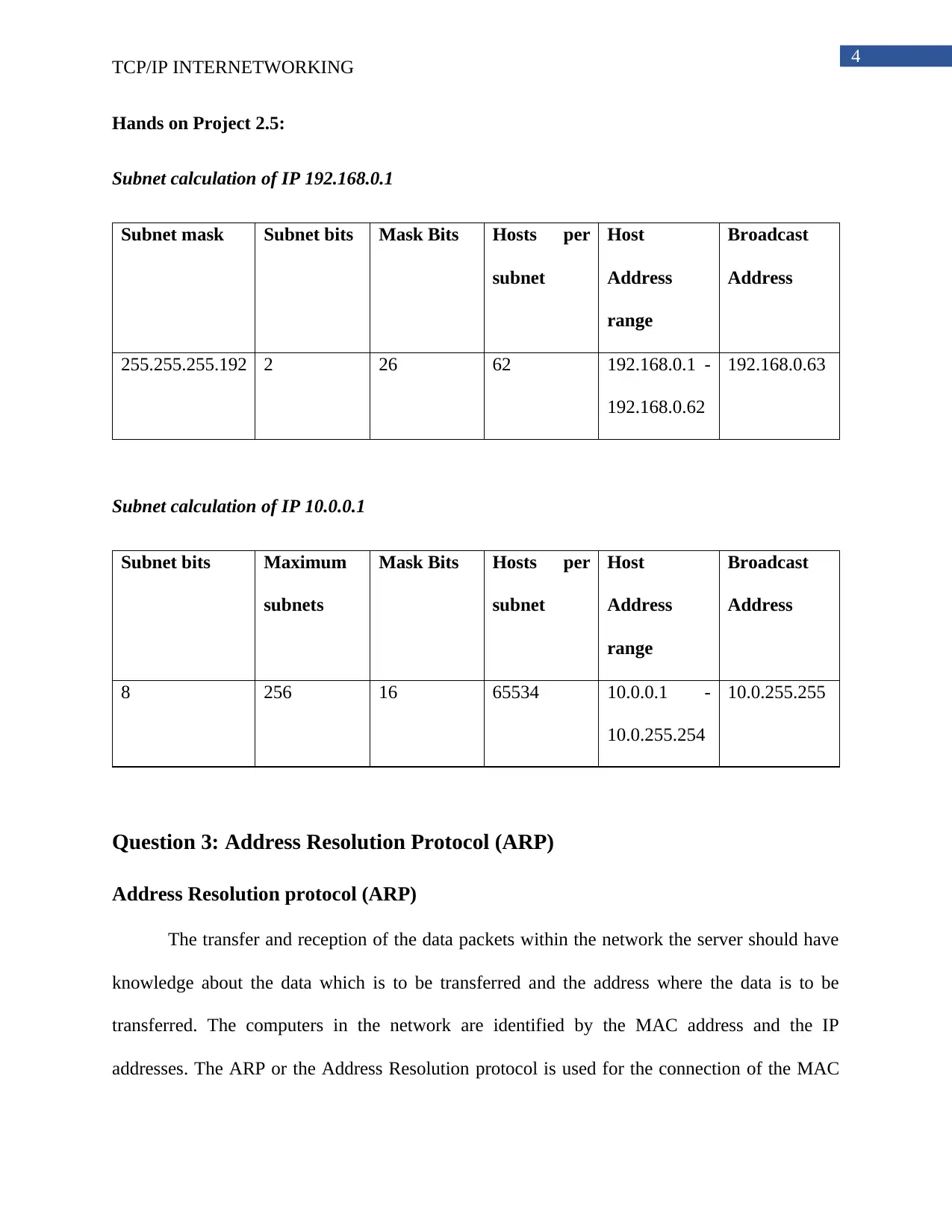
4
TCP/IP INTERNETWORKING
Hands on Project 2.5:
Subnet calculation of IP 192.168.0.1
Subnet mask Subnet bits Mask Bits Hosts per
subnet
Host
Address
range
Broadcast
Address
255.255.255.192 2 26 62 192.168.0.1 -
192.168.0.62
192.168.0.63
Subnet calculation of IP 10.0.0.1
Subnet bits Maximum
subnets
Mask Bits Hosts per
subnet
Host
Address
range
Broadcast
Address
8 256 16 65534 10.0.0.1 -
10.0.255.254
10.0.255.255
Question 3: Address Resolution Protocol (ARP)
Address Resolution protocol (ARP)
The transfer and reception of the data packets within the network the server should have
knowledge about the data which is to be transferred and the address where the data is to be
transferred. The computers in the network are identified by the MAC address and the IP
addresses. The ARP or the Address Resolution protocol is used for the connection of the MAC
TCP/IP INTERNETWORKING
Hands on Project 2.5:
Subnet calculation of IP 192.168.0.1
Subnet mask Subnet bits Mask Bits Hosts per
subnet
Host
Address
range
Broadcast
Address
255.255.255.192 2 26 62 192.168.0.1 -
192.168.0.62
192.168.0.63
Subnet calculation of IP 10.0.0.1
Subnet bits Maximum
subnets
Mask Bits Hosts per
subnet
Host
Address
range
Broadcast
Address
8 256 16 65534 10.0.0.1 -
10.0.255.254
10.0.255.255
Question 3: Address Resolution Protocol (ARP)
Address Resolution protocol (ARP)
The transfer and reception of the data packets within the network the server should have
knowledge about the data which is to be transferred and the address where the data is to be
transferred. The computers in the network are identified by the MAC address and the IP
addresses. The ARP or the Address Resolution protocol is used for the connection of the MAC
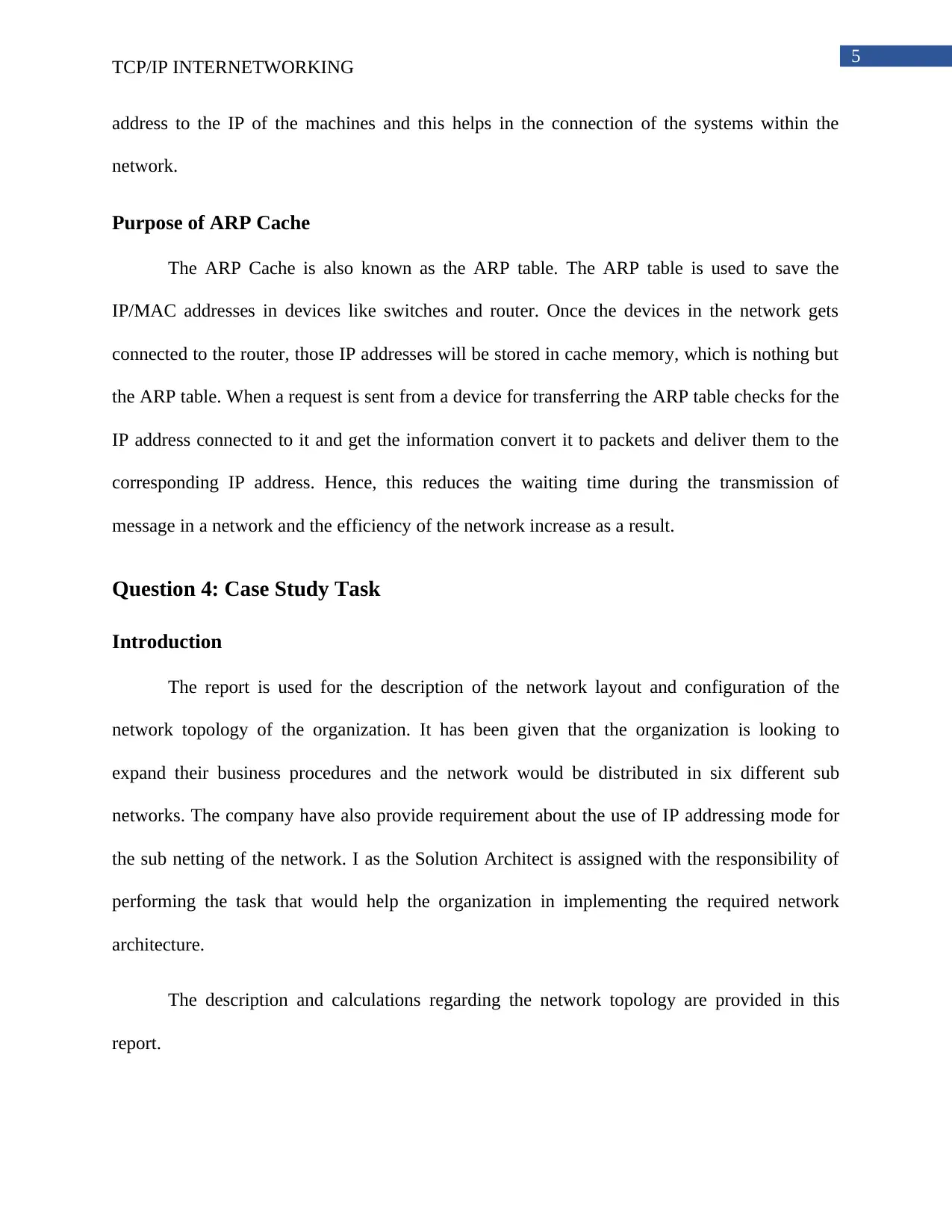
5
TCP/IP INTERNETWORKING
address to the IP of the machines and this helps in the connection of the systems within the
network.
Purpose of ARP Cache
The ARP Cache is also known as the ARP table. The ARP table is used to save the
IP/MAC addresses in devices like switches and router. Once the devices in the network gets
connected to the router, those IP addresses will be stored in cache memory, which is nothing but
the ARP table. When a request is sent from a device for transferring the ARP table checks for the
IP address connected to it and get the information convert it to packets and deliver them to the
corresponding IP address. Hence, this reduces the waiting time during the transmission of
message in a network and the efficiency of the network increase as a result.
Question 4: Case Study Task
Introduction
The report is used for the description of the network layout and configuration of the
network topology of the organization. It has been given that the organization is looking to
expand their business procedures and the network would be distributed in six different sub
networks. The company have also provide requirement about the use of IP addressing mode for
the sub netting of the network. I as the Solution Architect is assigned with the responsibility of
performing the task that would help the organization in implementing the required network
architecture.
The description and calculations regarding the network topology are provided in this
report.
TCP/IP INTERNETWORKING
address to the IP of the machines and this helps in the connection of the systems within the
network.
Purpose of ARP Cache
The ARP Cache is also known as the ARP table. The ARP table is used to save the
IP/MAC addresses in devices like switches and router. Once the devices in the network gets
connected to the router, those IP addresses will be stored in cache memory, which is nothing but
the ARP table. When a request is sent from a device for transferring the ARP table checks for the
IP address connected to it and get the information convert it to packets and deliver them to the
corresponding IP address. Hence, this reduces the waiting time during the transmission of
message in a network and the efficiency of the network increase as a result.
Question 4: Case Study Task
Introduction
The report is used for the description of the network layout and configuration of the
network topology of the organization. It has been given that the organization is looking to
expand their business procedures and the network would be distributed in six different sub
networks. The company have also provide requirement about the use of IP addressing mode for
the sub netting of the network. I as the Solution Architect is assigned with the responsibility of
performing the task that would help the organization in implementing the required network
architecture.
The description and calculations regarding the network topology are provided in this
report.
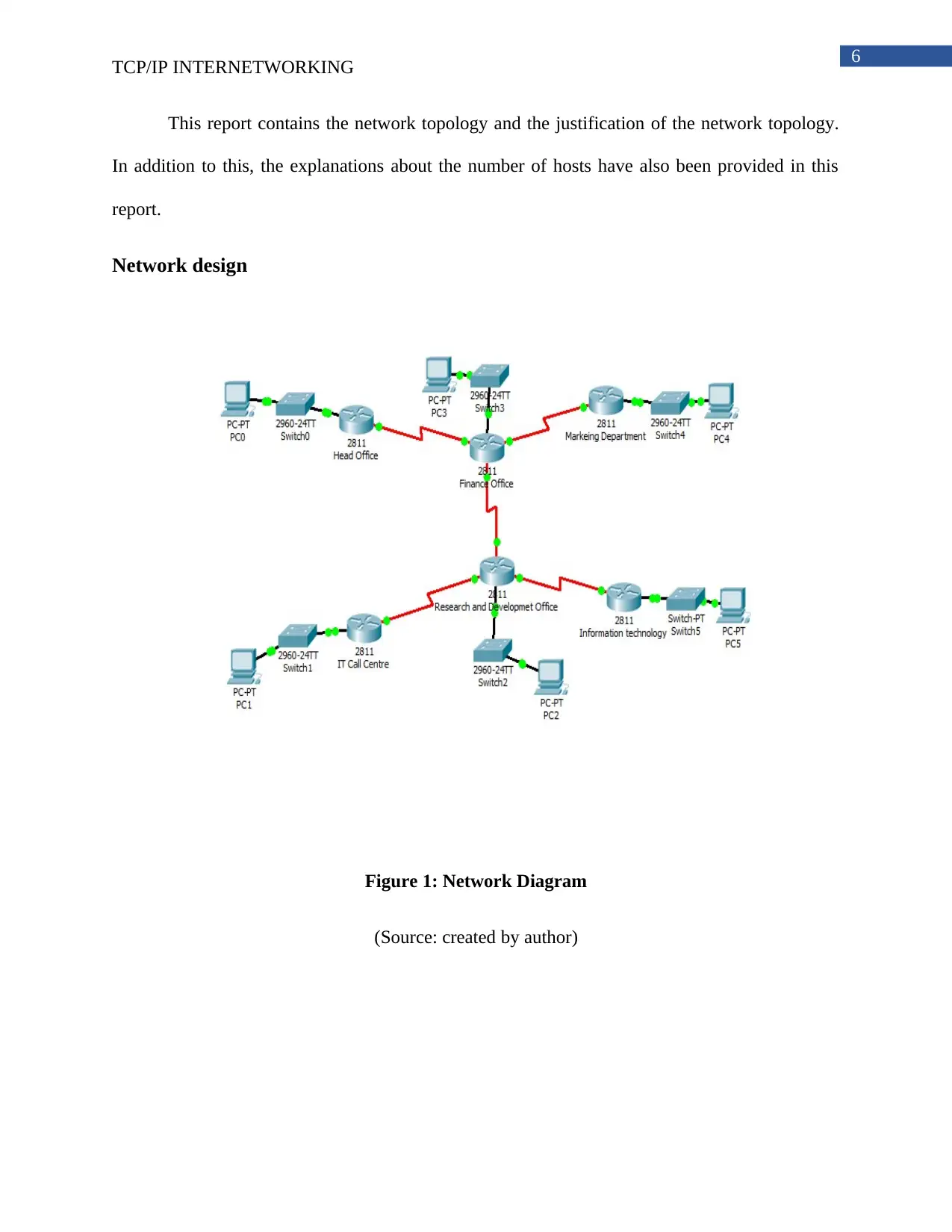
6
TCP/IP INTERNETWORKING
This report contains the network topology and the justification of the network topology.
In addition to this, the explanations about the number of hosts have also been provided in this
report.
Network design
Figure 1: Network Diagram
(Source: created by author)
TCP/IP INTERNETWORKING
This report contains the network topology and the justification of the network topology.
In addition to this, the explanations about the number of hosts have also been provided in this
report.
Network design
Figure 1: Network Diagram
(Source: created by author)
Paraphrase This Document
Need a fresh take? Get an instant paraphrase of this document with our AI Paraphraser
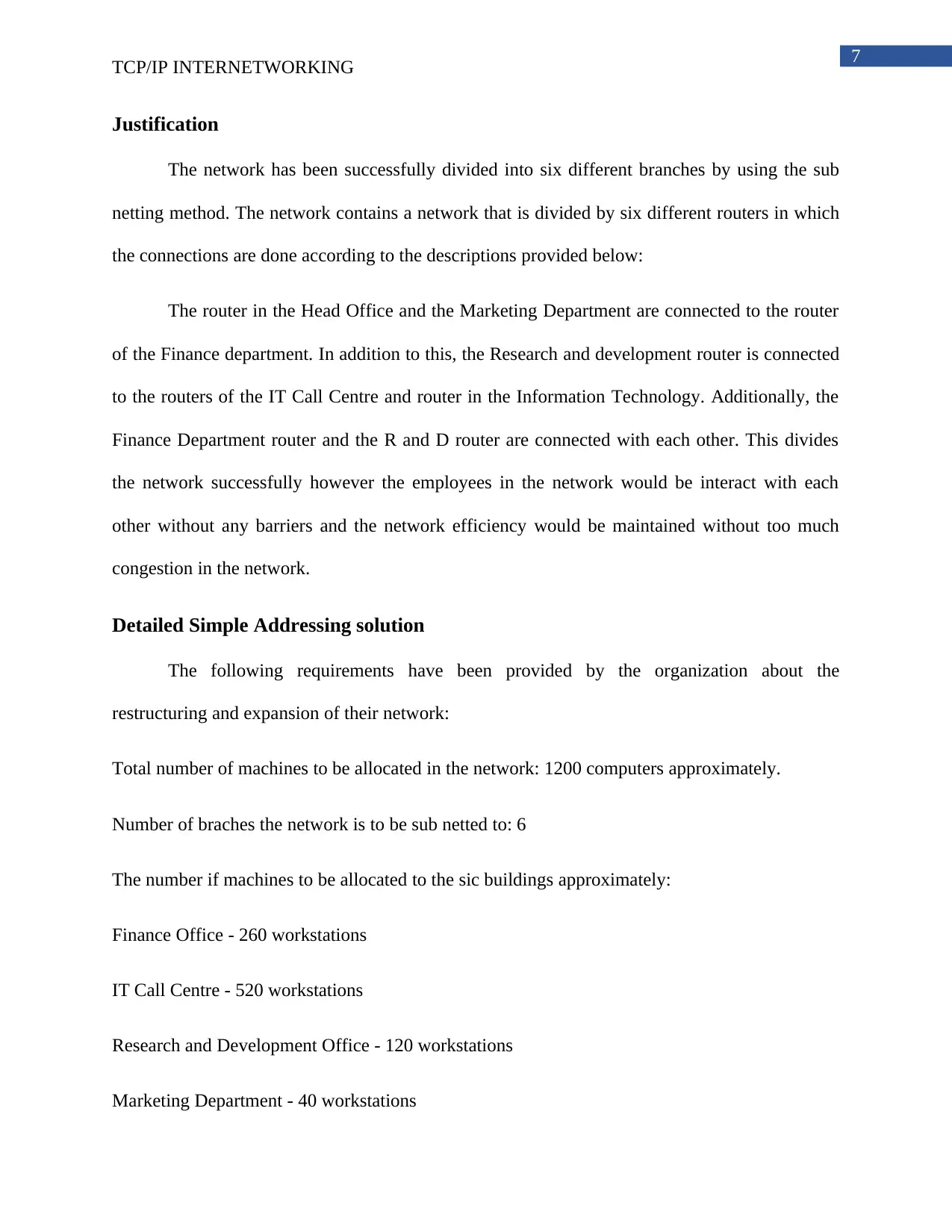
7
TCP/IP INTERNETWORKING
Justification
The network has been successfully divided into six different branches by using the sub
netting method. The network contains a network that is divided by six different routers in which
the connections are done according to the descriptions provided below:
The router in the Head Office and the Marketing Department are connected to the router
of the Finance department. In addition to this, the Research and development router is connected
to the routers of the IT Call Centre and router in the Information Technology. Additionally, the
Finance Department router and the R and D router are connected with each other. This divides
the network successfully however the employees in the network would be interact with each
other without any barriers and the network efficiency would be maintained without too much
congestion in the network.
Detailed Simple Addressing solution
The following requirements have been provided by the organization about the
restructuring and expansion of their network:
Total number of machines to be allocated in the network: 1200 computers approximately.
Number of braches the network is to be sub netted to: 6
The number if machines to be allocated to the sic buildings approximately:
Finance Office - 260 workstations
IT Call Centre - 520 workstations
Research and Development Office - 120 workstations
Marketing Department - 40 workstations
TCP/IP INTERNETWORKING
Justification
The network has been successfully divided into six different branches by using the sub
netting method. The network contains a network that is divided by six different routers in which
the connections are done according to the descriptions provided below:
The router in the Head Office and the Marketing Department are connected to the router
of the Finance department. In addition to this, the Research and development router is connected
to the routers of the IT Call Centre and router in the Information Technology. Additionally, the
Finance Department router and the R and D router are connected with each other. This divides
the network successfully however the employees in the network would be interact with each
other without any barriers and the network efficiency would be maintained without too much
congestion in the network.
Detailed Simple Addressing solution
The following requirements have been provided by the organization about the
restructuring and expansion of their network:
Total number of machines to be allocated in the network: 1200 computers approximately.
Number of braches the network is to be sub netted to: 6
The number if machines to be allocated to the sic buildings approximately:
Finance Office - 260 workstations
IT Call Centre - 520 workstations
Research and Development Office - 120 workstations
Marketing Department - 40 workstations
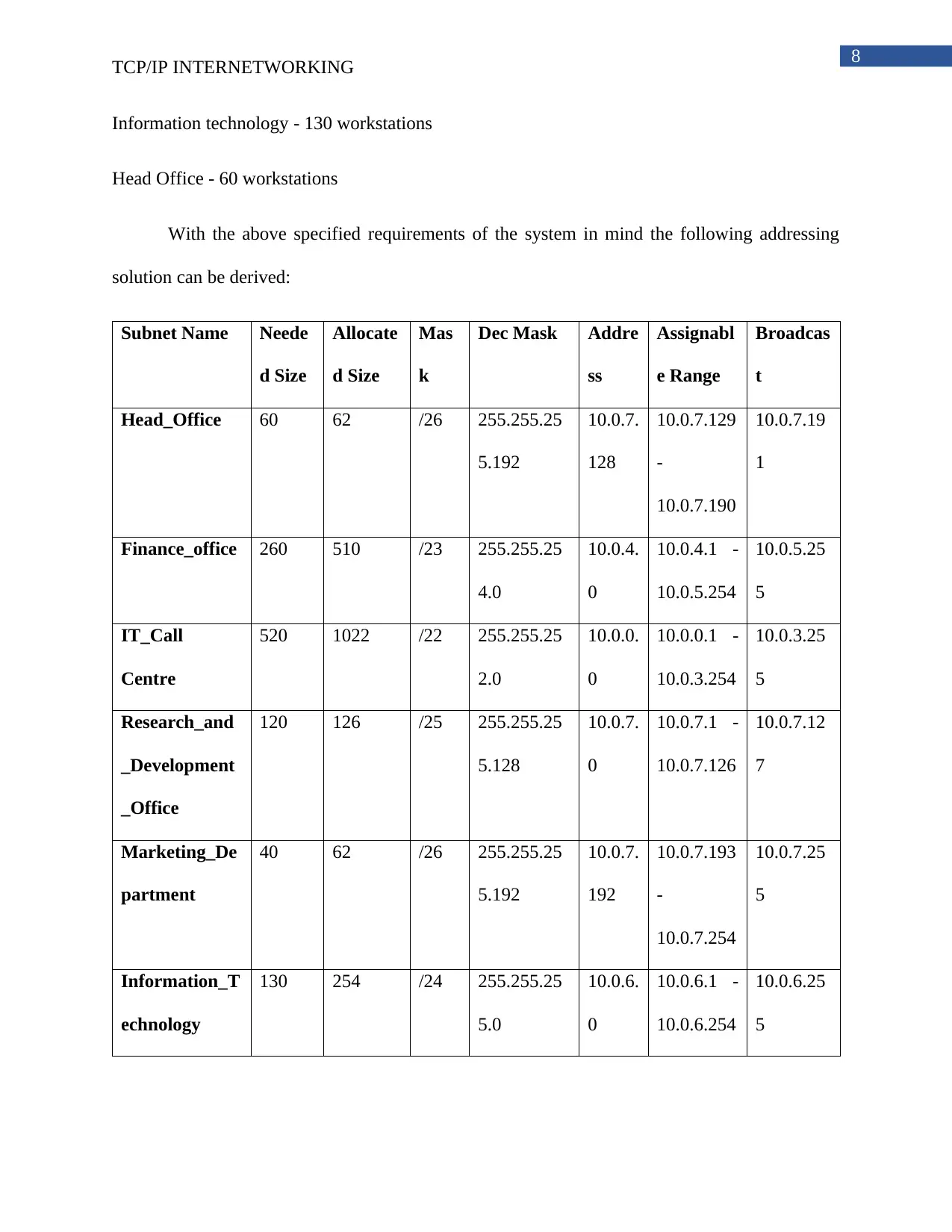
8
TCP/IP INTERNETWORKING
Information technology - 130 workstations
Head Office - 60 workstations
With the above specified requirements of the system in mind the following addressing
solution can be derived:
Subnet Name Neede
d Size
Allocate
d Size
Mas
k
Dec Mask Addre
ss
Assignabl
e Range
Broadcas
t
Head_Office 60 62 /26 255.255.25
5.192
10.0.7.
128
10.0.7.129
-
10.0.7.190
10.0.7.19
1
Finance_office 260 510 /23 255.255.25
4.0
10.0.4.
0
10.0.4.1 -
10.0.5.254
10.0.5.25
5
IT_Call
Centre
520 1022 /22 255.255.25
2.0
10.0.0.
0
10.0.0.1 -
10.0.3.254
10.0.3.25
5
Research_and
_Development
_Office
120 126 /25 255.255.25
5.128
10.0.7.
0
10.0.7.1 -
10.0.7.126
10.0.7.12
7
Marketing_De
partment
40 62 /26 255.255.25
5.192
10.0.7.
192
10.0.7.193
-
10.0.7.254
10.0.7.25
5
Information_T
echnology
130 254 /24 255.255.25
5.0
10.0.6.
0
10.0.6.1 -
10.0.6.254
10.0.6.25
5
TCP/IP INTERNETWORKING
Information technology - 130 workstations
Head Office - 60 workstations
With the above specified requirements of the system in mind the following addressing
solution can be derived:
Subnet Name Neede
d Size
Allocate
d Size
Mas
k
Dec Mask Addre
ss
Assignabl
e Range
Broadcas
t
Head_Office 60 62 /26 255.255.25
5.192
10.0.7.
128
10.0.7.129
-
10.0.7.190
10.0.7.19
1
Finance_office 260 510 /23 255.255.25
4.0
10.0.4.
0
10.0.4.1 -
10.0.5.254
10.0.5.25
5
IT_Call
Centre
520 1022 /22 255.255.25
2.0
10.0.0.
0
10.0.0.1 -
10.0.3.254
10.0.3.25
5
Research_and
_Development
_Office
120 126 /25 255.255.25
5.128
10.0.7.
0
10.0.7.1 -
10.0.7.126
10.0.7.12
7
Marketing_De
partment
40 62 /26 255.255.25
5.192
10.0.7.
192
10.0.7.193
-
10.0.7.254
10.0.7.25
5
Information_T
echnology
130 254 /24 255.255.25
5.0
10.0.6.
0
10.0.6.1 -
10.0.6.254
10.0.6.25
5
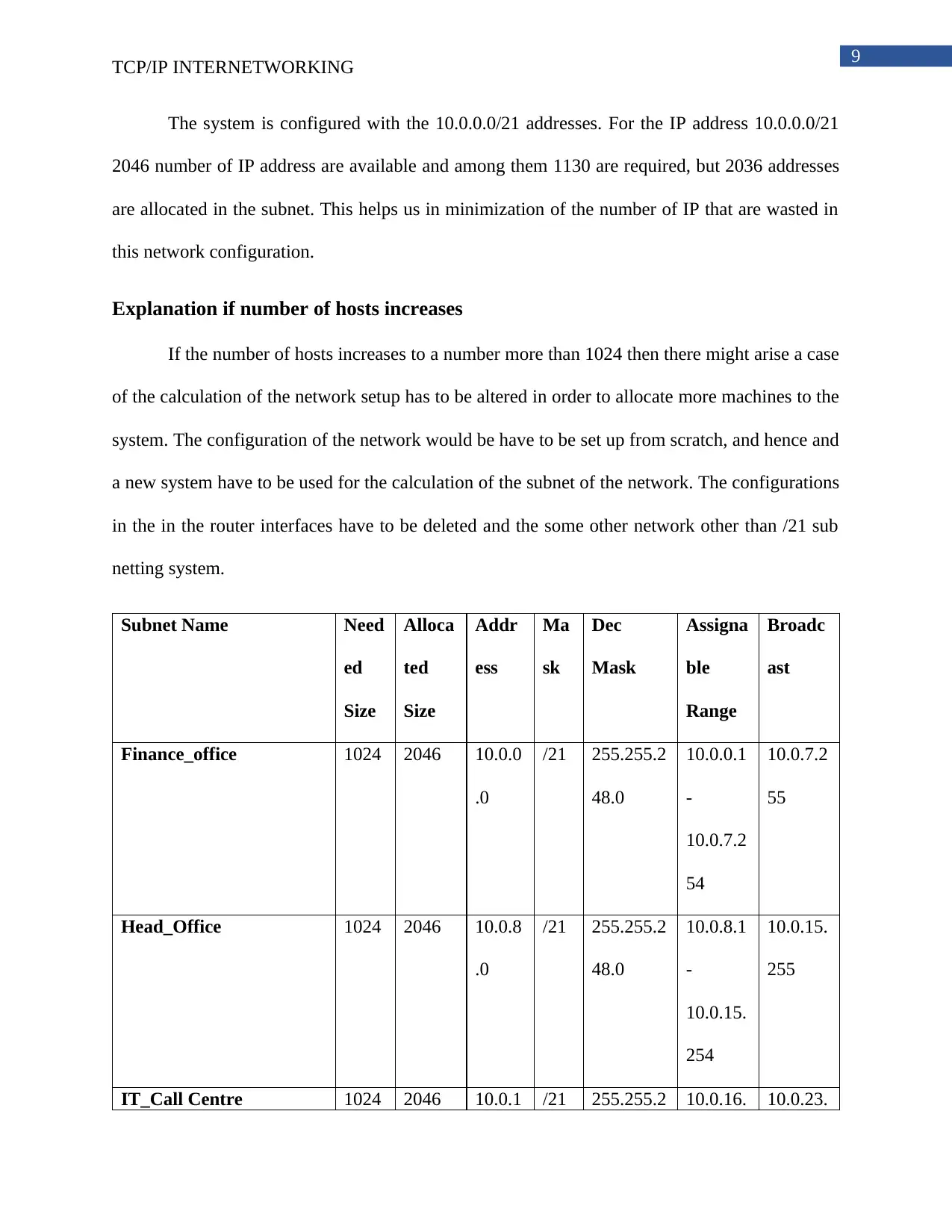
9
TCP/IP INTERNETWORKING
The system is configured with the 10.0.0.0/21 addresses. For the IP address 10.0.0.0/21
2046 number of IP address are available and among them 1130 are required, but 2036 addresses
are allocated in the subnet. This helps us in minimization of the number of IP that are wasted in
this network configuration.
Explanation if number of hosts increases
If the number of hosts increases to a number more than 1024 then there might arise a case
of the calculation of the network setup has to be altered in order to allocate more machines to the
system. The configuration of the network would be have to be set up from scratch, and hence and
a new system have to be used for the calculation of the subnet of the network. The configurations
in the in the router interfaces have to be deleted and the some other network other than /21 sub
netting system.
Subnet Name Need
ed
Size
Alloca
ted
Size
Addr
ess
Ma
sk
Dec
Mask
Assigna
ble
Range
Broadc
ast
Finance_office 1024 2046 10.0.0
.0
/21 255.255.2
48.0
10.0.0.1
-
10.0.7.2
54
10.0.7.2
55
Head_Office 1024 2046 10.0.8
.0
/21 255.255.2
48.0
10.0.8.1
-
10.0.15.
254
10.0.15.
255
IT_Call Centre 1024 2046 10.0.1 /21 255.255.2 10.0.16. 10.0.23.
TCP/IP INTERNETWORKING
The system is configured with the 10.0.0.0/21 addresses. For the IP address 10.0.0.0/21
2046 number of IP address are available and among them 1130 are required, but 2036 addresses
are allocated in the subnet. This helps us in minimization of the number of IP that are wasted in
this network configuration.
Explanation if number of hosts increases
If the number of hosts increases to a number more than 1024 then there might arise a case
of the calculation of the network setup has to be altered in order to allocate more machines to the
system. The configuration of the network would be have to be set up from scratch, and hence and
a new system have to be used for the calculation of the subnet of the network. The configurations
in the in the router interfaces have to be deleted and the some other network other than /21 sub
netting system.
Subnet Name Need
ed
Size
Alloca
ted
Size
Addr
ess
Ma
sk
Dec
Mask
Assigna
ble
Range
Broadc
ast
Finance_office 1024 2046 10.0.0
.0
/21 255.255.2
48.0
10.0.0.1
-
10.0.7.2
54
10.0.7.2
55
Head_Office 1024 2046 10.0.8
.0
/21 255.255.2
48.0
10.0.8.1
-
10.0.15.
254
10.0.15.
255
IT_Call Centre 1024 2046 10.0.1 /21 255.255.2 10.0.16. 10.0.23.
Secure Best Marks with AI Grader
Need help grading? Try our AI Grader for instant feedback on your assignments.
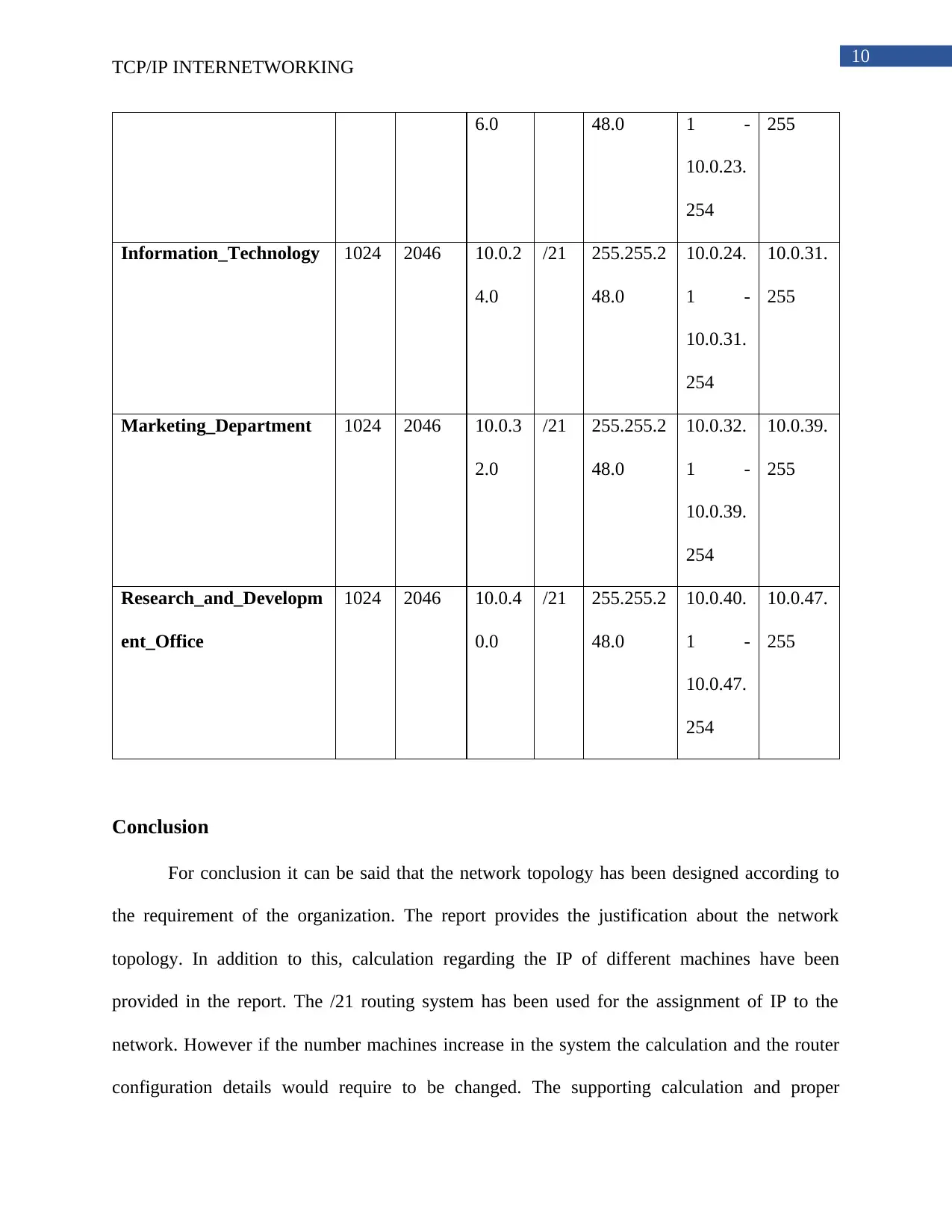
10
TCP/IP INTERNETWORKING
6.0 48.0 1 -
10.0.23.
254
255
Information_Technology 1024 2046 10.0.2
4.0
/21 255.255.2
48.0
10.0.24.
1 -
10.0.31.
254
10.0.31.
255
Marketing_Department 1024 2046 10.0.3
2.0
/21 255.255.2
48.0
10.0.32.
1 -
10.0.39.
254
10.0.39.
255
Research_and_Developm
ent_Office
1024 2046 10.0.4
0.0
/21 255.255.2
48.0
10.0.40.
1 -
10.0.47.
254
10.0.47.
255
Conclusion
For conclusion it can be said that the network topology has been designed according to
the requirement of the organization. The report provides the justification about the network
topology. In addition to this, calculation regarding the IP of different machines have been
provided in the report. The /21 routing system has been used for the assignment of IP to the
network. However if the number machines increase in the system the calculation and the router
configuration details would require to be changed. The supporting calculation and proper
TCP/IP INTERNETWORKING
6.0 48.0 1 -
10.0.23.
254
255
Information_Technology 1024 2046 10.0.2
4.0
/21 255.255.2
48.0
10.0.24.
1 -
10.0.31.
254
10.0.31.
255
Marketing_Department 1024 2046 10.0.3
2.0
/21 255.255.2
48.0
10.0.32.
1 -
10.0.39.
254
10.0.39.
255
Research_and_Developm
ent_Office
1024 2046 10.0.4
0.0
/21 255.255.2
48.0
10.0.40.
1 -
10.0.47.
254
10.0.47.
255
Conclusion
For conclusion it can be said that the network topology has been designed according to
the requirement of the organization. The report provides the justification about the network
topology. In addition to this, calculation regarding the IP of different machines have been
provided in the report. The /21 routing system has been used for the assignment of IP to the
network. However if the number machines increase in the system the calculation and the router
configuration details would require to be changed. The supporting calculation and proper
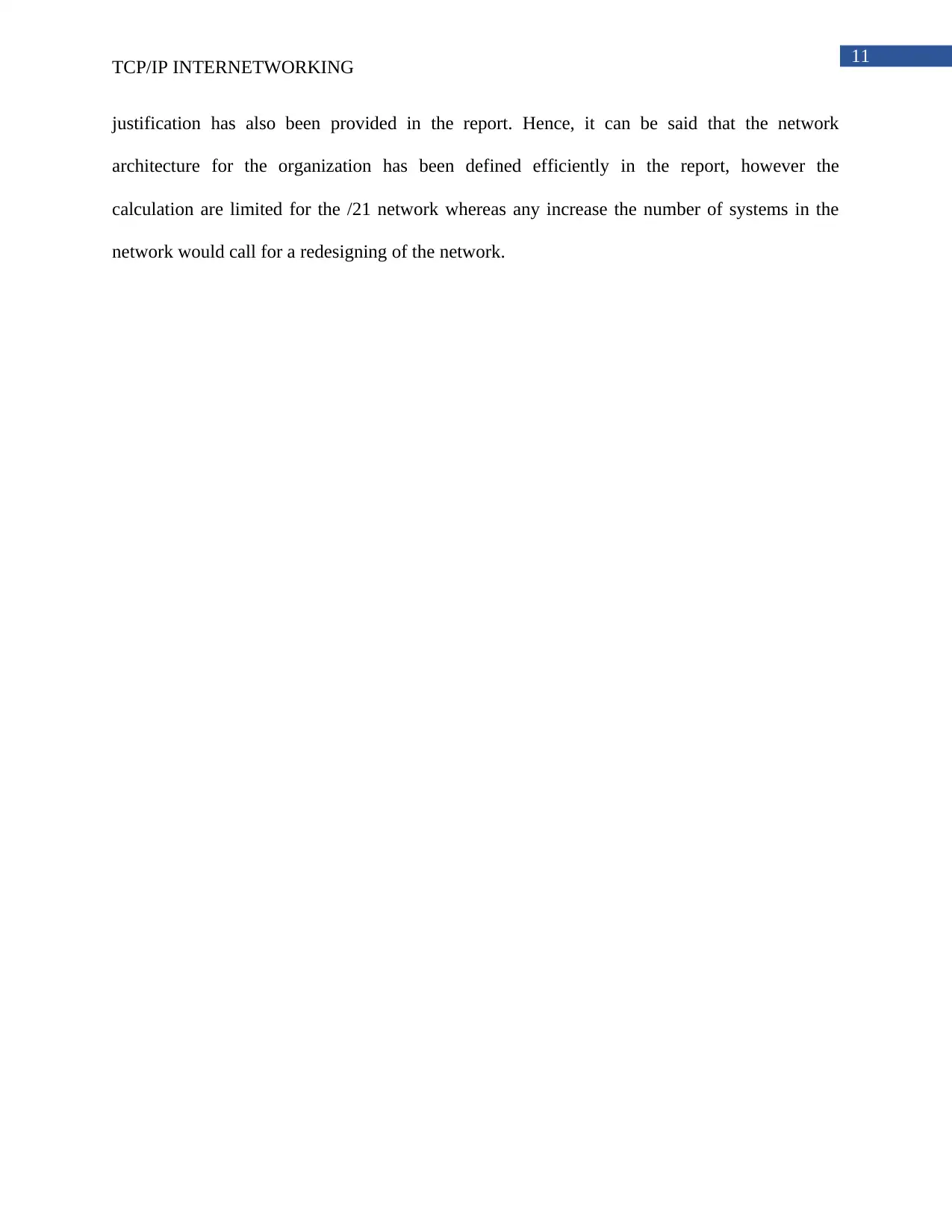
11
TCP/IP INTERNETWORKING
justification has also been provided in the report. Hence, it can be said that the network
architecture for the organization has been defined efficiently in the report, however the
calculation are limited for the /21 network whereas any increase the number of systems in the
network would call for a redesigning of the network.
TCP/IP INTERNETWORKING
justification has also been provided in the report. Hence, it can be said that the network
architecture for the organization has been defined efficiently in the report, however the
calculation are limited for the /21 network whereas any increase the number of systems in the
network would call for a redesigning of the network.
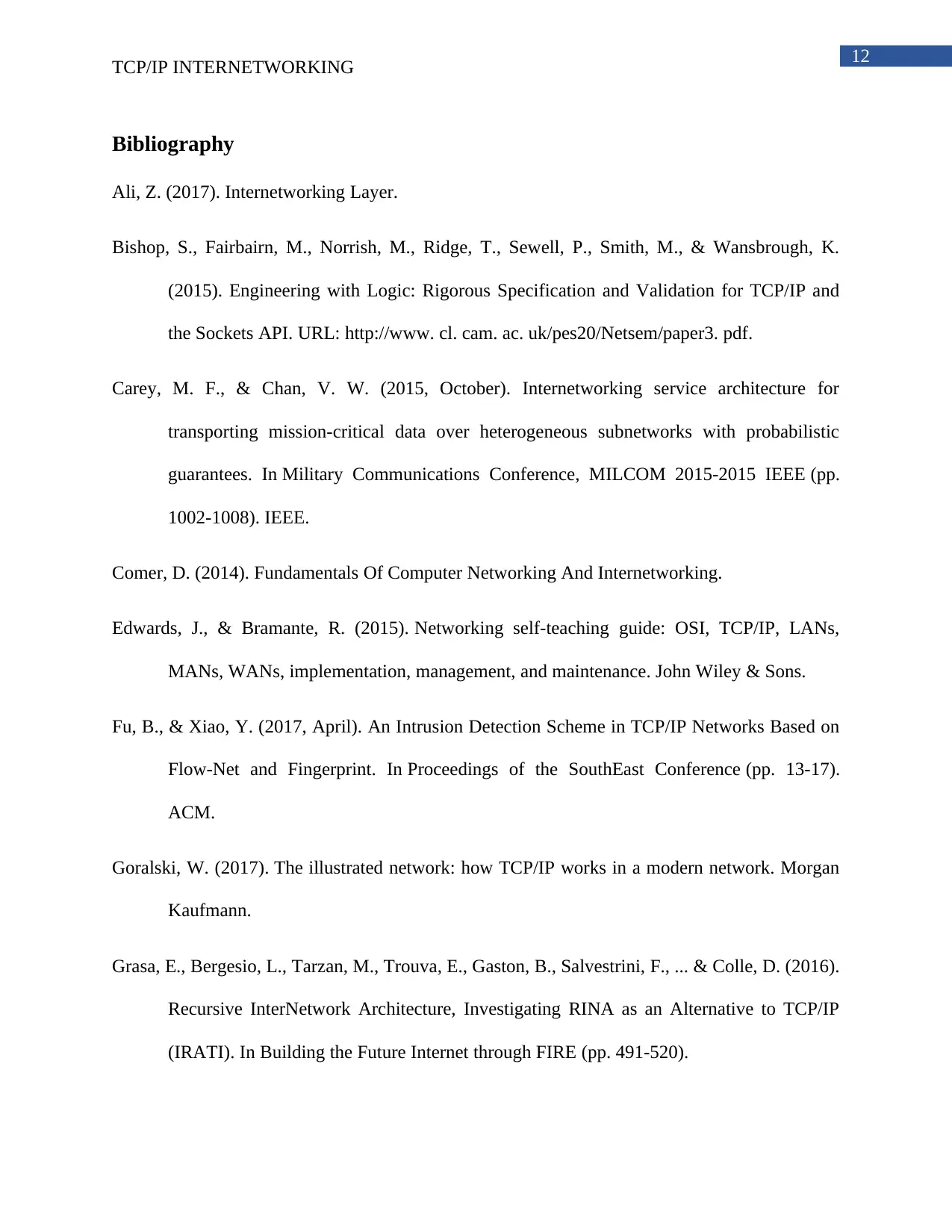
12
TCP/IP INTERNETWORKING
Bibliography
Ali, Z. (2017). Internetworking Layer.
Bishop, S., Fairbairn, M., Norrish, M., Ridge, T., Sewell, P., Smith, M., & Wansbrough, K.
(2015). Engineering with Logic: Rigorous Specification and Validation for TCP/IP and
the Sockets API. URL: http://www. cl. cam. ac. uk/pes20/Netsem/paper3. pdf.
Carey, M. F., & Chan, V. W. (2015, October). Internetworking service architecture for
transporting mission-critical data over heterogeneous subnetworks with probabilistic
guarantees. In Military Communications Conference, MILCOM 2015-2015 IEEE (pp.
1002-1008). IEEE.
Comer, D. (2014). Fundamentals Of Computer Networking And Internetworking.
Edwards, J., & Bramante, R. (2015). Networking self-teaching guide: OSI, TCP/IP, LANs,
MANs, WANs, implementation, management, and maintenance. John Wiley & Sons.
Fu, B., & Xiao, Y. (2017, April). An Intrusion Detection Scheme in TCP/IP Networks Based on
Flow-Net and Fingerprint. In Proceedings of the SouthEast Conference (pp. 13-17).
ACM.
Goralski, W. (2017). The illustrated network: how TCP/IP works in a modern network. Morgan
Kaufmann.
Grasa, E., Bergesio, L., Tarzan, M., Trouva, E., Gaston, B., Salvestrini, F., ... & Colle, D. (2016).
Recursive InterNetwork Architecture, Investigating RINA as an Alternative to TCP/IP
(IRATI). In Building the Future Internet through FIRE (pp. 491-520).
TCP/IP INTERNETWORKING
Bibliography
Ali, Z. (2017). Internetworking Layer.
Bishop, S., Fairbairn, M., Norrish, M., Ridge, T., Sewell, P., Smith, M., & Wansbrough, K.
(2015). Engineering with Logic: Rigorous Specification and Validation for TCP/IP and
the Sockets API. URL: http://www. cl. cam. ac. uk/pes20/Netsem/paper3. pdf.
Carey, M. F., & Chan, V. W. (2015, October). Internetworking service architecture for
transporting mission-critical data over heterogeneous subnetworks with probabilistic
guarantees. In Military Communications Conference, MILCOM 2015-2015 IEEE (pp.
1002-1008). IEEE.
Comer, D. (2014). Fundamentals Of Computer Networking And Internetworking.
Edwards, J., & Bramante, R. (2015). Networking self-teaching guide: OSI, TCP/IP, LANs,
MANs, WANs, implementation, management, and maintenance. John Wiley & Sons.
Fu, B., & Xiao, Y. (2017, April). An Intrusion Detection Scheme in TCP/IP Networks Based on
Flow-Net and Fingerprint. In Proceedings of the SouthEast Conference (pp. 13-17).
ACM.
Goralski, W. (2017). The illustrated network: how TCP/IP works in a modern network. Morgan
Kaufmann.
Grasa, E., Bergesio, L., Tarzan, M., Trouva, E., Gaston, B., Salvestrini, F., ... & Colle, D. (2016).
Recursive InterNetwork Architecture, Investigating RINA as an Alternative to TCP/IP
(IRATI). In Building the Future Internet through FIRE (pp. 491-520).
Paraphrase This Document
Need a fresh take? Get an instant paraphrase of this document with our AI Paraphraser
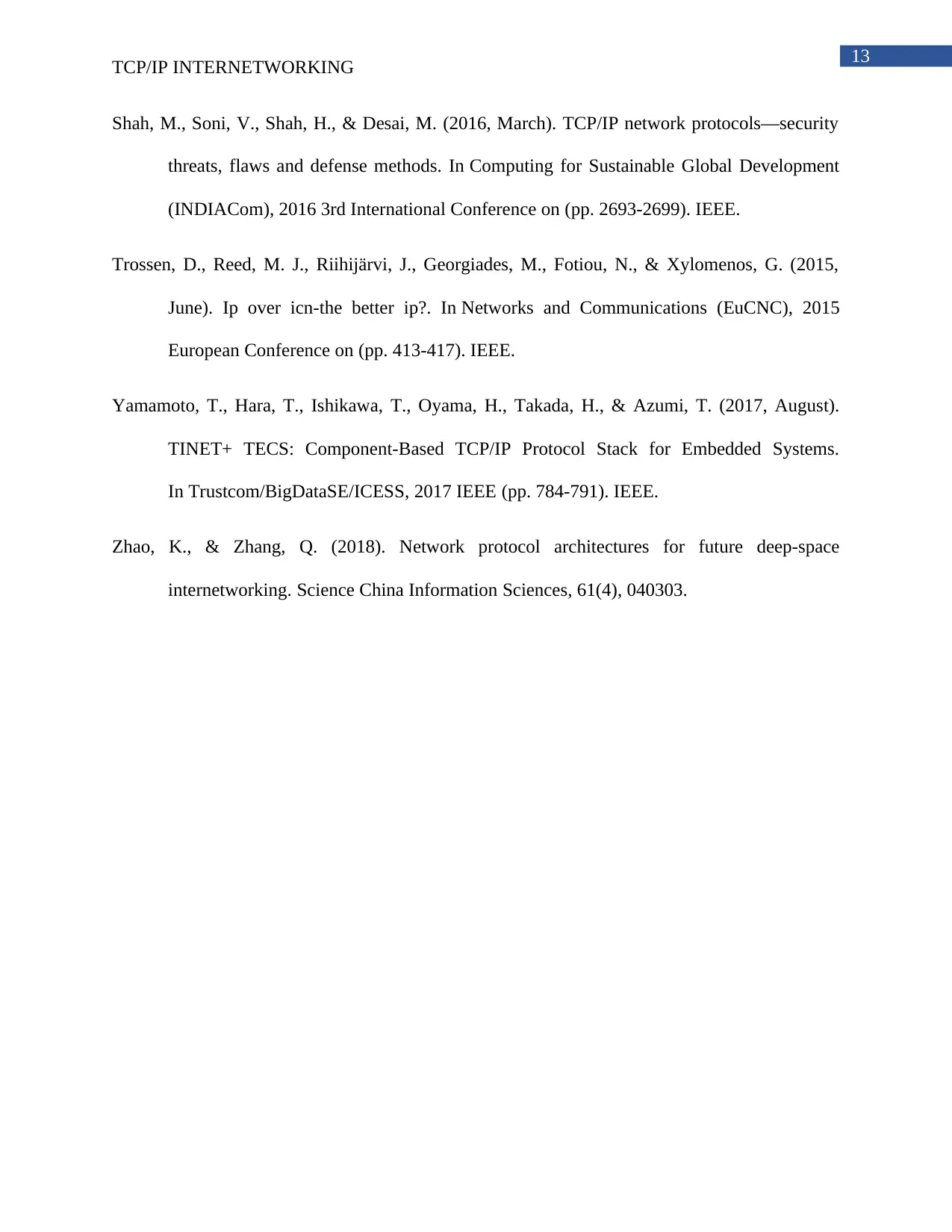
13
TCP/IP INTERNETWORKING
Shah, M., Soni, V., Shah, H., & Desai, M. (2016, March). TCP/IP network protocols—security
threats, flaws and defense methods. In Computing for Sustainable Global Development
(INDIACom), 2016 3rd International Conference on (pp. 2693-2699). IEEE.
Trossen, D., Reed, M. J., Riihijärvi, J., Georgiades, M., Fotiou, N., & Xylomenos, G. (2015,
June). Ip over icn-the better ip?. In Networks and Communications (EuCNC), 2015
European Conference on (pp. 413-417). IEEE.
Yamamoto, T., Hara, T., Ishikawa, T., Oyama, H., Takada, H., & Azumi, T. (2017, August).
TINET+ TECS: Component-Based TCP/IP Protocol Stack for Embedded Systems.
In Trustcom/BigDataSE/ICESS, 2017 IEEE (pp. 784-791). IEEE.
Zhao, K., & Zhang, Q. (2018). Network protocol architectures for future deep-space
internetworking. Science China Information Sciences, 61(4), 040303.
TCP/IP INTERNETWORKING
Shah, M., Soni, V., Shah, H., & Desai, M. (2016, March). TCP/IP network protocols—security
threats, flaws and defense methods. In Computing for Sustainable Global Development
(INDIACom), 2016 3rd International Conference on (pp. 2693-2699). IEEE.
Trossen, D., Reed, M. J., Riihijärvi, J., Georgiades, M., Fotiou, N., & Xylomenos, G. (2015,
June). Ip over icn-the better ip?. In Networks and Communications (EuCNC), 2015
European Conference on (pp. 413-417). IEEE.
Yamamoto, T., Hara, T., Ishikawa, T., Oyama, H., Takada, H., & Azumi, T. (2017, August).
TINET+ TECS: Component-Based TCP/IP Protocol Stack for Embedded Systems.
In Trustcom/BigDataSE/ICESS, 2017 IEEE (pp. 784-791). IEEE.
Zhao, K., & Zhang, Q. (2018). Network protocol architectures for future deep-space
internetworking. Science China Information Sciences, 61(4), 040303.
1 out of 14
Related Documents
Your All-in-One AI-Powered Toolkit for Academic Success.
+13062052269
info@desklib.com
Available 24*7 on WhatsApp / Email
![[object Object]](/_next/static/media/star-bottom.7253800d.svg)
Unlock your academic potential
© 2024 | Zucol Services PVT LTD | All rights reserved.



